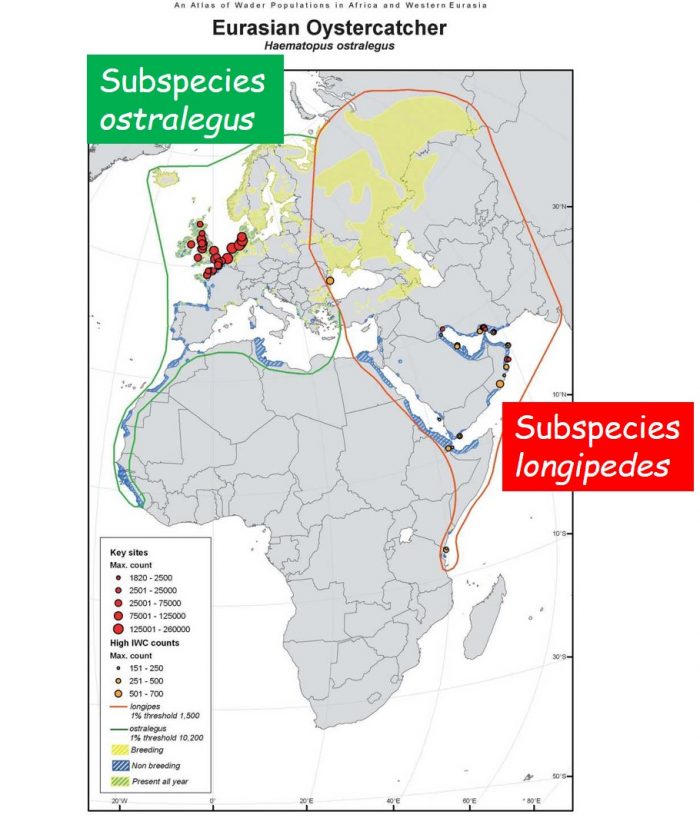The Eurasian Oystercatcher Haematopus ostralegus breeds in Europe and Asia. Most move south for the northern winter. Most remain in soutern Europe, some migrate to northern Africa, and tiny numbers reach the southern end of Africa.
Identification
This is the only black and white oystercatcher that occurs anywhere on the African continent. As its name implies, it breeds in Europe and Asia, and travels to Africa as a migrant.

There are other species of black and white oystercatchers, but they occur in North and South America and in Australia and New Zealand.
This is the call.
Habitat
Whereas African Black Oystercatchers occur on both rocky and sandy shores, Eurasian Oystercatchers prefer soft, sandy or muddy substrates. So they are mostly found at lagoons and large sandy estuaries. This young Eurasian Oystercatcher, at the Gamtoos River Estuary in the Eastern Cape, is in classic habitat for the species.

Distribution
On the Atlantic Ocean coast of southern Africa, they have mostly been recorded at Walvis Bay Lagoon and Sandwich Harbour in Namibia, and at Langebaan Lagoon in South Africa. Along the Indian Ocean coast, there are many suitable estuaries and lagoons from about Plettenberg Bay, eastwards through the Eastern Cape and KwaZulu-Natal in South Africa, and in Mozambique. But they can turn up anywhere along the coast.

Two subspecies of the Eurasian Oystercatcher have African connections. The normal range of the western subspecies ostralegus is outlined in green in the map below, and that of the eastern subspecies longipedes in red. The difference between the two subspecies are subtle; longipedes has a slightly longer bill than ostralegus. On this map, breeding areas are shaded yellow, and non-breeding areas in blue. Neither subspecies normally reaches southern Africa. The western subspecies ostralesgus occurs along the coastline of northwest Africa. The eastern subspecies longipedes migrates as far south along the eastern coast of Africa to Tanzania. It is thought that the birds reaching southern Africa (including Namibia) are longipedes, arriving along the east coast of Africa. In reality, we don’t really know!

Breeding
In broad brush terms there is a huge difference between the two subspecies; during the breeding season ostralegus is (traditionally) on saltwater coastlines of the oceans of western Europe, and longipedes on freshwater margins of lakes and large rivers of the interior of the eastern half of Europe. This is shown on the map below. But, from about the middle of the 20th century, ostralegus started breeding inland in agricultural landscapes, even 100 km from the sea, where they feed on earthworms, rather than on molluscs.

Gallery
The pictures below are selected from the BirdPix section of the Virtual Museum.

This is probably the largest flock of Eurasian Oystercatchers south if the “normal” nonbreeding range shown in the map above. This flock of about 20 birds was at San Sebastian, Vilanculos, Mozambique.

This is the experience you are on the lookout for; a Eurasian Oystercatcher in a flock of African Black Oystercatchers. Keep looking. This was at Walvis Bay Lagoon.

Further resources: A selection of papers
- Conservation Status of Oystercatchers Around the World (2014). Three chapters deal with the Eurasian Oystercatcher. (1) Conservation assessment of Haematopus ostralegus longipes , (2) Population estimate of Haematopus ostralegus longipes based on non-breeding numbers in January, and (3) A global assessment of the conservation status of the nominate subspecies of Eurasian Oystercatcher Haematopus ostralegus ostralegus. These chapters are in a monograph published by the International Wader Study Group.
More common names: Bonttobie (Afrikaans), Huîtrier pie (French), Austernfischer (German), Ostraceiro (Portuguese), Ostrero Euroasiático (Spanish)
Photographic acknowledgements: Most of the photographs in this identification guide are in the BDI/FitzPatrick Institute Virtual Museum. They are used here with permission of the photographers, who continue to own the copyright on these images. Top image: Alan Collett, BirdPix 143367. Identification image: Dave Rimmer, BirdPix 58147. Habitat image: Gregg Darling, BirdPix 104255. First gallery image: Georg Jacobs BirdPix 99051. Second gallery image: Maans Booysen, BirdPix 102228. Third Gallery image: Les Underhill BirdPix 1415.
Recommended citation format: Underhill LG 2021. Eurasian Oystercatcher Haematopus ostralegus. Biodiversity and Development Institute. Available online at http://thebdi.org/2021/06/14/eurasian-oystercatcher-haematopus-ostralegus/

